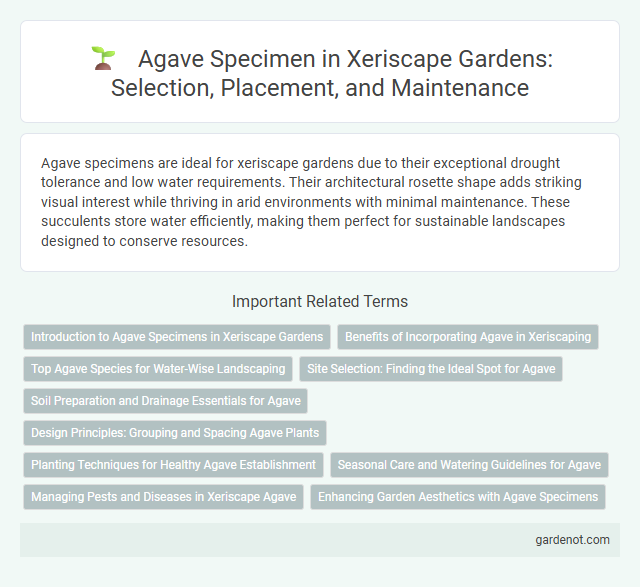Agave specimens are ideal for xeriscape gardens due to their exceptional drought tolerance and low water requirements. Their architectural rosette shape adds striking visual interest while thriving in arid environments with minimal maintenance. These succulents store water efficiently, making them perfect for sustainable landscapes designed to conserve resources.
Introduction to Agave Specimens in Xeriscape Gardens
Agave specimens are essential xeriscape plants known for their drought tolerance and striking architectural form, making them ideal for water-efficient gardens. Their thick, fleshy leaves store water, allowing survival in arid climates with minimal irrigation. Agave species such as Agave americana and Agave parryi are popular choices, providing both visual interest and low maintenance in xeriscape landscapes.
Benefits of Incorporating Agave in Xeriscaping
Agave species thrive in arid environments due to their low water requirements, making them ideal for xeriscaping. Their deep root systems improve soil stability and reduce erosion, while their thick, waxy leaves minimize water loss through transpiration. Incorporating Agave enhances landscape aesthetics with bold architectural forms and supports sustainable water conservation efforts in drought-prone areas.
Top Agave Species for Water-Wise Landscaping
Agave americana, Agave parryi, and Agave vilmoriniana are among the top agave species ideal for water-wise landscaping due to their drought tolerance and striking architectural form. These species thrive in arid environments, requiring minimal irrigation while providing dramatic foliage that enhances xeriscape garden aesthetics. Their slow growth and low maintenance needs contribute to sustainable, water-efficient landscape designs in dry climates.
Site Selection: Finding the Ideal Spot for Agave
Agave thrives best in well-drained soils with full sun exposure, making south-facing slopes or open desert landscapes ideal for planting. Avoid areas prone to heavy frost or excessive moisture, as these conditions can cause root rot and damage to the plant. Selecting a site with ample space ensures proper air circulation, reducing disease risk and supporting healthy Agave growth.
Soil Preparation and Drainage Essentials for Agave
Optimal soil preparation for Agave involves well-draining, sandy or gravelly substrates that mimic its native arid habitats. Incorporating coarse sand or small gravel enhances aeration and prevents water retention, which is critical to avoiding root rot. Proper drainage systems, such as raised beds or sloped planting sites, ensure excess water efficiently moves away from the root zone, maintaining healthy Agave growth.
Design Principles: Grouping and Spacing Agave Plants
Grouping Agave plants enhances visual impact and creates a focal point in xeriscape designs, maximizing water efficiency by reducing evaporation. Proper spacing between specimens allows for mature growth without overcrowding, promoting healthy air circulation and minimizing pest issues. Strategic arrangement of Agave clusters leverages their architectural form, providing texture contrast and balanced composition in drought-tolerant landscapes.
Planting Techniques for Healthy Agave Establishment
Plant Agave specimens in well-draining soil with a pH range of 6.5 to 7.5 to prevent root rot and ensure optimal growth. Position the plant crown slightly above the soil line to allow for proper air circulation and reduce moisture buildup. Incorporate mulch composed of small gravel or decomposed granite to maintain soil temperature and retain moisture without causing waterlogging.
Seasonal Care and Watering Guidelines for Agave
Agave specimens thrive with minimal watering, requiring deep irrigation every 2 to 3 weeks during active growth in spring and summer, while needing almost no water in dormant winter months. Seasonal care involves removing dead leaves and monitoring for pests, ensuring the plant remains healthy and resilient in xeriscape landscapes. Well-drained soil and full sun exposure optimize water efficiency and support agave's drought-tolerant nature.
Managing Pests and Diseases in Xeriscape Agave
Effective management of pests and diseases in xeriscape Agave involves regular inspection for common issues like agave snout weevils and fungal infections. Applying preventive measures, such as ensuring proper drainage and avoiding overwatering, reduces susceptibility to root rot and other moisture-related problems. Using targeted insecticides and fungicides at the first sign of infestation or infection helps maintain plant health and longevity in drought-tolerant landscapes.
Enhancing Garden Aesthetics with Agave Specimens
Agave specimens elevate garden aesthetics by offering striking architectural forms and bold textures that create visual interest year-round. Their diverse varieties range from compact rosettes to towering spike-like leaves, providing versatile design options for xeriscape landscapes. Drought-tolerant qualities reduce maintenance while adding sculptural beauty, making Agave an essential focal point in sustainable garden design.
Agave specimen Infographic

 gardenot.com
gardenot.com